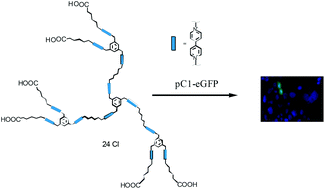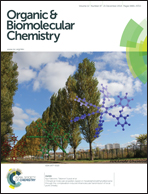Alkylene-bridged viologen dendrimers: versatile cell delivery tools with biosensing properties†
Abstract
The synthesis of two types of viologen dendrimers with peripheral carboxyl groups is described. Their interaction with plasmid DNA and CT-DNA and the influence of time evolution and electrolyte on dendriplex formation have been electrochemically investigated. A negative potential shift appearing in the cyclic voltammograms of the dendrimers indicates dendriplex formation on the time scale of 15 to 19 minutes, i.e. similar to those determined empirically for other dendrimer types. The presence or absence of the negative potential shift can be used to check the stability towards sodium chloride and different cell growth media directing to sucrose for cell incubation experiments. The electrolyte content of commercially available cell growth media inhibits the dendriplex formation in solution prior to plasmid addition. Furthermore, a low salt stability of 20 mM sodium chloride for viologen dendriplexes has been confirmed, also recommending the use of lysosomotropic sucrose. The two types of viologen dendrimers have been combined with two plasmids differing in the number of base pairs. Four immortal cell lines have been tested to check the suitability of viologen dendriplexes as gene delivery systems. Probably due to the absence of terminal amino groups and endosomolytic substances only a small transfection efficiency of dendriplexes was achieved at low pH, generally excluding in vivo applications. With the larger pHSV-eGFP plasmid (5743 bp) no transfected cells were observed indicating a preference for shorter plasmids.


 Please wait while we load your content...
Please wait while we load your content...